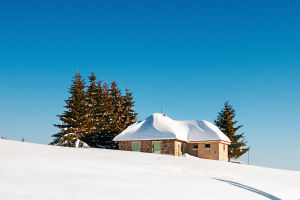The villa, as a form of residential architecture, originally originated from the country estates of ancient Rome. Over time, its form and function have continuously evolved.
In modern society, the villa has become a unique mode of living, symbolizing people’s pursuit of quality of life and their need for personalized spaces.
This article will explore in detail the evolution and main characteristics of modern villas to help readers better understand this architectural type.
1. Evolution
The term "villa" comes from the Latin word "Vila," originally referring to country estates of Roman nobility. During the Middle Ages in Europe, villas were also commonly used as vacation retreats for the nobility and wealthy merchants.
By the 19th century, with the advancement of the Industrial Revolution and accelerated urbanization, people began to seek residential environments away from the city’s hustle and bustle, and the villa gradually became a symbol of wealth and status.
In the early 20th century, the rise of modernist architecture fundamentally changed villa design concepts. Architects such as Le Corbusier and Frank Lloyd Wright introduced functionalism and minimalism, emphasizing the functionality of buildings and simplicity of form. At this time, villas began to move away from elaborate decorations toward simple lines and practical spatial layouts.
Entering the 21st century, modern villas have diversified in design, incorporating more environmental and technological elements. Green building concepts, smart home technology, and personalized customization have become important components of modern villa design. A villa is no longer just a living space but has become a place to showcase personal taste and lifestyle.
2. Key Features
Modern villas typically employ open space layouts, breaking away from traditional room separations to make indoor spaces more fluid and transparent.
Living rooms, dining areas, and kitchens are often merged into a large open area, not only improving space efficiency but also creating a spacious and comfortable living environment.
Large glass windows are a notable feature in modern villa design. These extensive windows not only provide ample natural light but also bring outdoor views inside, allowing residents to feel more connected to nature.
With the rise in environmental awareness, modern villas increasingly focus on energy efficiency and sustainability in their designs. Common eco-friendly measures include the selection of building materials, energy-efficient systems, and green roofs. Additionally, solar panels, rainwater recycling systems, and high-efficiency insulation materials are widely used in modern villas.
Modern villas often come equipped with advanced smart home systems. These systems include smart lighting, automatic curtains, temperature control systems, and security systems, all of which can be conveniently managed through smartphones or voice control, enhancing both convenience and safety in daily living.
The design of modern villas also emphasizes personalization and customization. Architects and designers tailor the villa's layout and decor according to the client’s needs and lifestyle. For example, some villas are specially designed with home theaters, gyms, or art studios to meet the unique requirements of the residents.
Summary
Modern villas are not just living spaces but reflect lifestyle and personalized taste.
With advancements in technology and increased environmental awareness, modern villas continuously innovate in design, incorporating open layouts, eco-friendly features, smart home systems, and customized elements. Understanding these characteristics and trends can help us better appreciate and choose a modern villa that brings more comfort and convenience to our lives.


